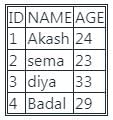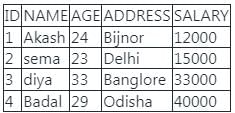Computer Science Engineering (CSE) Exam > Computer Science Engineering (CSE) Questions > _______ symbol is used to see every column of...
Start Learning for Free
_______ symbol is used to see every column of a table.
- a)/
- b)_ _
- c)*
- d)!
Correct answer is option 'C'. Can you explain this answer?
Verified Answer
_______ symbol is used to see every column of a table.a)/b)_ _c)*d)!Co...
The * symbol is used to see every column of a table.
For Example, Let us consider a table Table1

For Example, Let us consider a table Table1

If you want to fetch only some specific columns from the table, then we can use this query,
Select ID,NAME,AGE from Table1; // Syntax is Select (column_name1, coloumn_name2.....coloum_name) from table_name;

Select ID,NAME,AGE from Table1; // Syntax is Select (column_name1, coloumn_name2.....coloum_name) from table_name;

If you want to fetch all the fields of the Table1 table, then you should use the following query ,
Select * from Table1; // Syntax is Select * from table_name;

Select * from Table1; // Syntax is Select * from table_name;

Therefore Option 3 is correct
Most Upvoted Answer
_______ symbol is used to see every column of a table.a)/b)_ _c)*d)!Co...
Explanation:
Symbol for Viewing Every Column in a Table:
- In SQL, the asterisk symbol (*) is used to represent all columns in a table.
- When you use the asterisk symbol in the SELECT statement, it retrieves all columns from the specified table.
Example:
- For example, if you have a table called "employees" with columns such as "id", "name", "department", and "salary", you can use the following query to select all columns:
sql
SELECT * FROM employees;
- This query will return all columns for every row in the "employees" table.
Benefits of Using the Asterisk Symbol:
- Using the asterisk symbol (*) is convenient when you want to retrieve all columns from a table without specifying each column individually.
- It saves time and effort, especially when dealing with tables that have a large number of columns.
Limitations:
- While using the asterisk symbol is convenient, it is important to note that it may not be the most efficient way to retrieve data, especially in large databases.
- Retrieving unnecessary columns can impact the performance of your queries and increase network traffic.
Conclusion:
- In summary, the asterisk symbol (*) is used to view every column of a table in SQL queries. It provides a quick and easy way to retrieve all columns from a table, but it is important to consider the potential drawbacks in terms of performance and efficiency.
Symbol for Viewing Every Column in a Table:
- In SQL, the asterisk symbol (*) is used to represent all columns in a table.
- When you use the asterisk symbol in the SELECT statement, it retrieves all columns from the specified table.
Example:
- For example, if you have a table called "employees" with columns such as "id", "name", "department", and "salary", you can use the following query to select all columns:
sql
SELECT * FROM employees;
- This query will return all columns for every row in the "employees" table.
Benefits of Using the Asterisk Symbol:
- Using the asterisk symbol (*) is convenient when you want to retrieve all columns from a table without specifying each column individually.
- It saves time and effort, especially when dealing with tables that have a large number of columns.
Limitations:
- While using the asterisk symbol is convenient, it is important to note that it may not be the most efficient way to retrieve data, especially in large databases.
- Retrieving unnecessary columns can impact the performance of your queries and increase network traffic.
Conclusion:
- In summary, the asterisk symbol (*) is used to view every column of a table in SQL queries. It provides a quick and easy way to retrieve all columns from a table, but it is important to consider the potential drawbacks in terms of performance and efficiency.

|
Explore Courses for Computer Science Engineering (CSE) exam
|

|
Question Description
_______ symbol is used to see every column of a table.a)/b)_ _c)*d)!Correct answer is option 'C'. Can you explain this answer? for Computer Science Engineering (CSE) 2025 is part of Computer Science Engineering (CSE) preparation. The Question and answers have been prepared according to the Computer Science Engineering (CSE) exam syllabus. Information about _______ symbol is used to see every column of a table.a)/b)_ _c)*d)!Correct answer is option 'C'. Can you explain this answer? covers all topics & solutions for Computer Science Engineering (CSE) 2025 Exam. Find important definitions, questions, meanings, examples, exercises and tests below for _______ symbol is used to see every column of a table.a)/b)_ _c)*d)!Correct answer is option 'C'. Can you explain this answer?.
_______ symbol is used to see every column of a table.a)/b)_ _c)*d)!Correct answer is option 'C'. Can you explain this answer? for Computer Science Engineering (CSE) 2025 is part of Computer Science Engineering (CSE) preparation. The Question and answers have been prepared according to the Computer Science Engineering (CSE) exam syllabus. Information about _______ symbol is used to see every column of a table.a)/b)_ _c)*d)!Correct answer is option 'C'. Can you explain this answer? covers all topics & solutions for Computer Science Engineering (CSE) 2025 Exam. Find important definitions, questions, meanings, examples, exercises and tests below for _______ symbol is used to see every column of a table.a)/b)_ _c)*d)!Correct answer is option 'C'. Can you explain this answer?.
Solutions for _______ symbol is used to see every column of a table.a)/b)_ _c)*d)!Correct answer is option 'C'. Can you explain this answer? in English & in Hindi are available as part of our courses for Computer Science Engineering (CSE).
Download more important topics, notes, lectures and mock test series for Computer Science Engineering (CSE) Exam by signing up for free.
Here you can find the meaning of _______ symbol is used to see every column of a table.a)/b)_ _c)*d)!Correct answer is option 'C'. Can you explain this answer? defined & explained in the simplest way possible. Besides giving the explanation of
_______ symbol is used to see every column of a table.a)/b)_ _c)*d)!Correct answer is option 'C'. Can you explain this answer?, a detailed solution for _______ symbol is used to see every column of a table.a)/b)_ _c)*d)!Correct answer is option 'C'. Can you explain this answer? has been provided alongside types of _______ symbol is used to see every column of a table.a)/b)_ _c)*d)!Correct answer is option 'C'. Can you explain this answer? theory, EduRev gives you an
ample number of questions to practice _______ symbol is used to see every column of a table.a)/b)_ _c)*d)!Correct answer is option 'C'. Can you explain this answer? tests, examples and also practice Computer Science Engineering (CSE) tests.

|
Explore Courses for Computer Science Engineering (CSE) exam
|

|
Signup for Free!
Signup to see your scores go up within 7 days! Learn & Practice with 1000+ FREE Notes, Videos & Tests.


















